1997 CADILLAC SEVILLE check engine light
[x] Cancel search: check engine lightPage 37 of 370
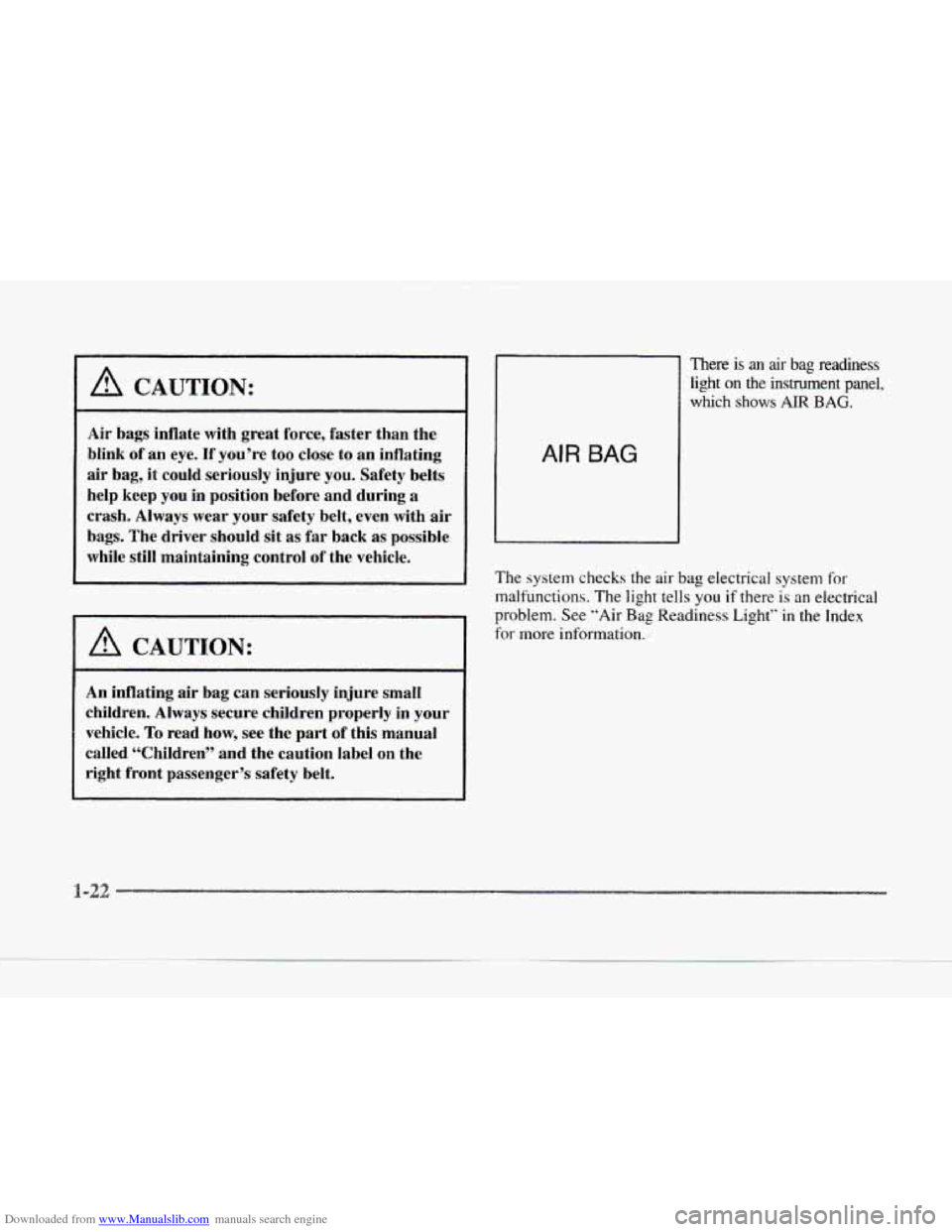
Downloaded from www.Manualslib.com manuals search engine A CAUTION:
Air bags inflate with great force, faster than the
blink
of an eye. If you’re too close to an inflating
air bag,
it could seriously injure you. Safety belts
help keep you in position before and during a
crash. Always wear your safety belt., even with air
bags. The driver should sit as far back as possible
while still maintaining control
of the vehicle.
A CAUTION:
An inflating air bag can seriously injure small
children. Always secure children properly in your
vehicle.
To read how, see the part of this manual
called “Children”
and the caution label on the
right front passenger’s safety belt.
AIR BAG
There is an air bag readiness
light
on the instrument panel,
which shows
AIR BAG.
The system checks the air bag electrical system for
malfunctions.
The light tells you if there is an electrical
problem. See “Air
Bag Readiness Light” in the Index
for more information.
-22
Page 78 of 370
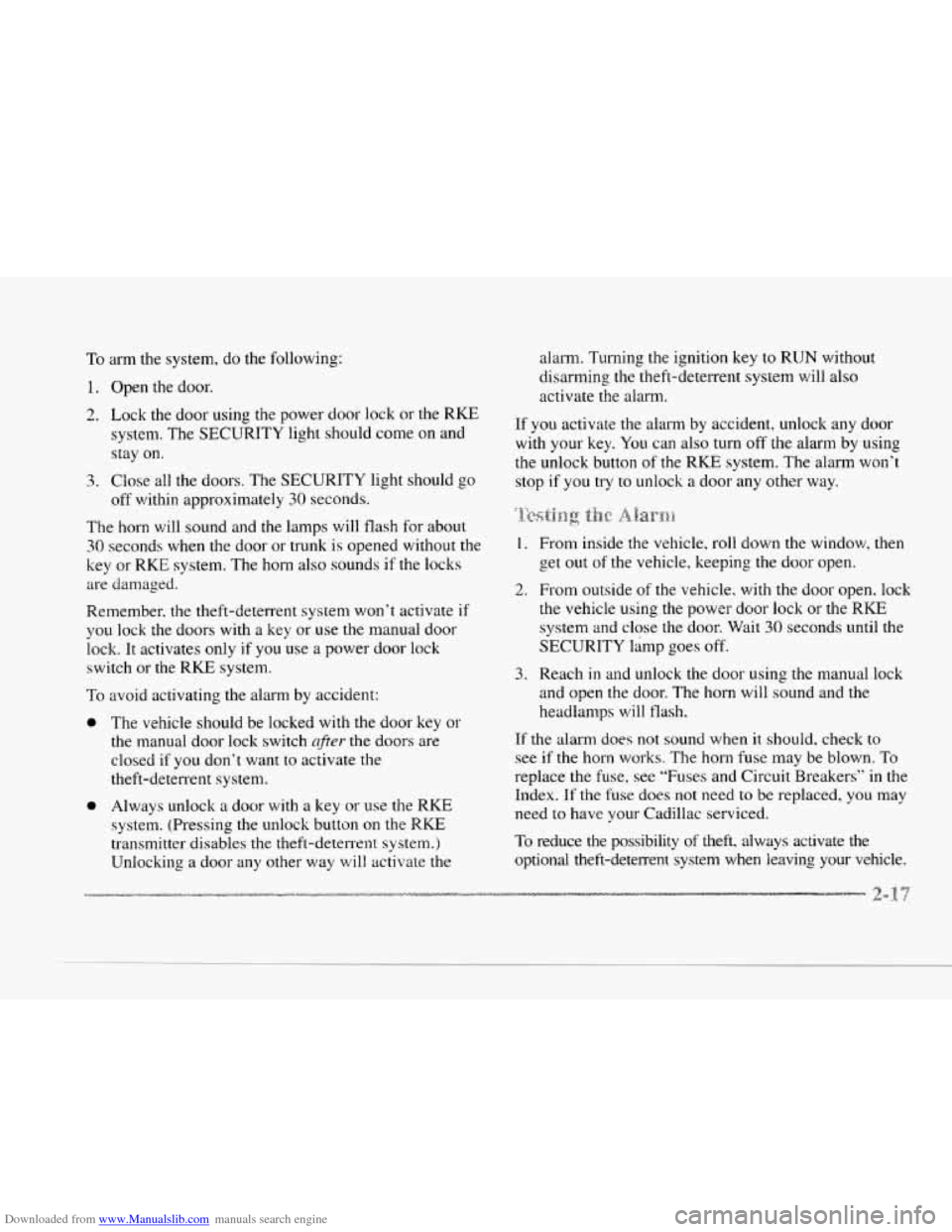
Downloaded from www.Manualslib.com manuals search engine c
.--
To
1.
2.
3.
i arm the system, do the following:
Open the door.
Lock the door using the power door lock
or the RKE
system. The SECURITY light should come on and
stay on.
Close all
the doors. The SECURITY light should go
off within approximately 30 seconds.
The horn will sound and the lamps will flash for about
30 seconds when the door or trunk is opened without the
key
or RKE system. The horn also sounds if the loclcs
are damaged.
Remember. the theft-deterrent system won't activate if
you lock the doors with a key or use the manual door
lock. It activates only
if you use a power door lock
switch or the RKE system.
TO
0
0
i avoid activating the alarm by accident:
The vehicle should be locked with the door key
or
the manual door lock switch after- the doors are
closed if
you don't want to activate the
theft-deterrent system.
Always unlock
a door with a key or use the RKE
system. (Pressing the unlock button on the RKE
transmitter disables the theft-detell-ent system. j
Unlocking a door any other way will activate the alarm.
Turning the ignition key
to RUN without
disarming the theft-deterrent system will
also
activate the alarm.
If you activate the alarm by accident, unlock any door
with your key.
You car1 also turn off the alarm by using
the unlock button of the RKE system. The alarm won't
stop if
you try to unlock a door any other way.
:l'&$,jg.]gg. tj3e $Jj8T:"Xhj
1. From inside the vehicle, roll down the window, then
c% "'
b met out of the vehicle, keeping the door open.
2. From outside of the vehicle, with the door open. lock
the vehicle using the
power door lock or the RKE
system
and close the door. Wait 30 seconds until the
SECURITY limp goes off.
3. Reach in and unlock the door using the manual lock
and open the door. The horn will sound and the
headlamps
will flash.
If the alarm does not sound when it should, check to
see if the horn works. The horn fuse may be blown. To
replace the fuse, see "Fuses and Circuit Breakers'' in the
Index. If the fuse
does not need to be replaced, you may
need
to have your Cadillac serviced.
To reduce the possibility of theft, always activate the
optional theft-detelrent system when leaving your vehicle.
c
Page 135 of 370
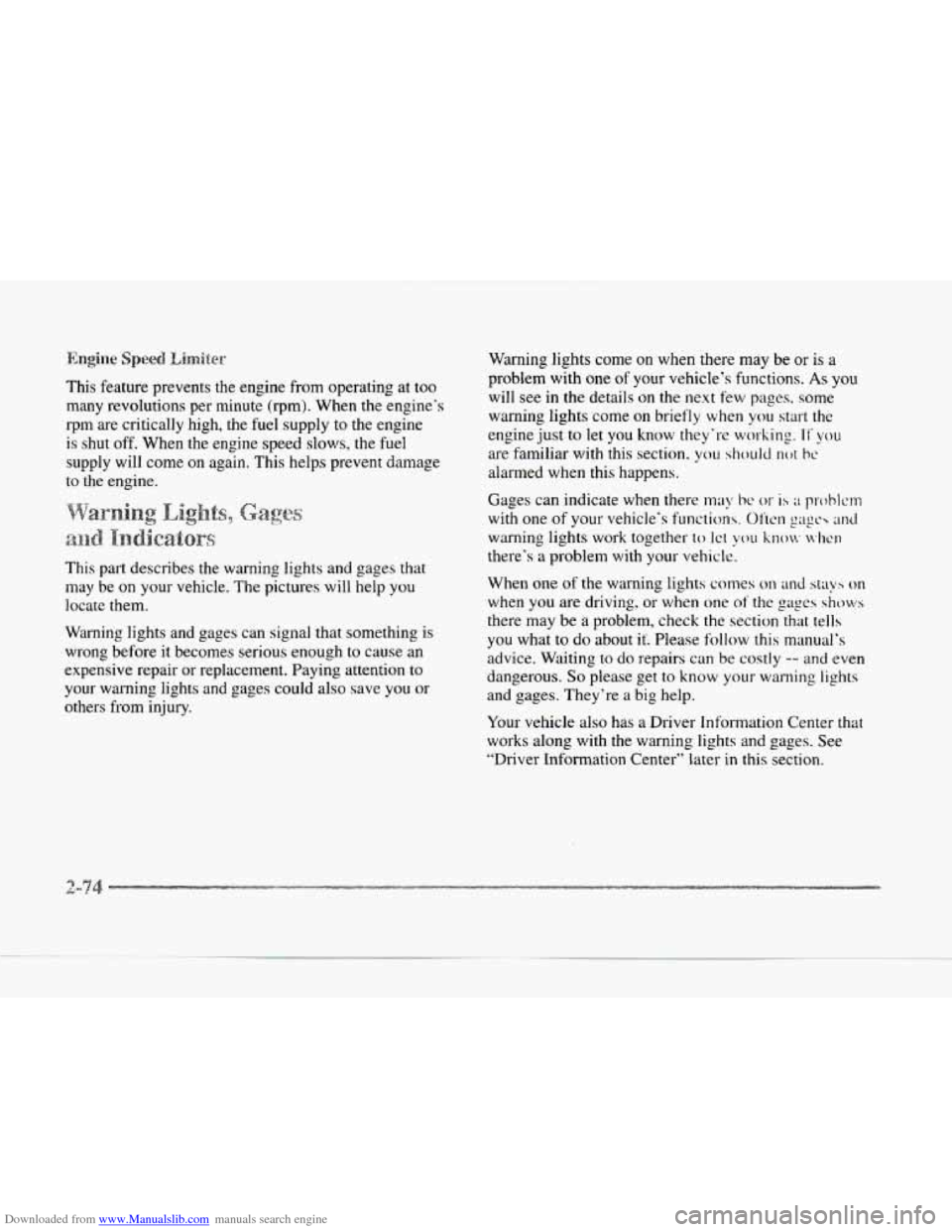
Downloaded from www.Manualslib.com manuals search engine This feature prevents the engine from operating at too
many revolutions per minute (rprn). When the engine’s
rpm are critically high, the fuel supply to the engine
is shut
off. When the engine speed slows, the fuel
supply will come on again. This helps prevent damage
to the engine.
This part describes the warning lights and gages that
may be on your vehicle. The pictures will help you
locate them.
Warning lights and gages can signal that something is
wrong before
it becomes serious enough to cause an
expensive repair
or replacement. Paying attention to
your warning lights and gages could also save
you or
others from injury. Warning
lights come
on when there may be or is a
problem with
one of your vehicle’s functions. As you
will see in
the details on the next few pages. some
warning lights come on briefly when
you start the
engine just
to let you know they‘re working. If’ ~OLI
are familiar with this section. you should IWI he
alarmed when this happens.
Gages can indicate when there
may bc or is ;: prohlcn;
with one of your vehicle‘s functions. Oftcn pgch and
warning lights work together to let you kno~, ~,hw
there‘s a problem with your vehicle.
When one of the warning lights comes
on and stays on
when you are driving, or when one of the gages shows
there may be a problem, check the section that tells
you what to do about it Please follow this manual’s
advice. Waiting
to do repairs can be costly -- and even
dangerous.
So please get to know your warning lights
and gages. They’re a big help.
Your vehicle also has a Driver Information Center that
works along with the warning lights and gages. See
“Driver Information Center” later
in this section.
Page 136 of 370
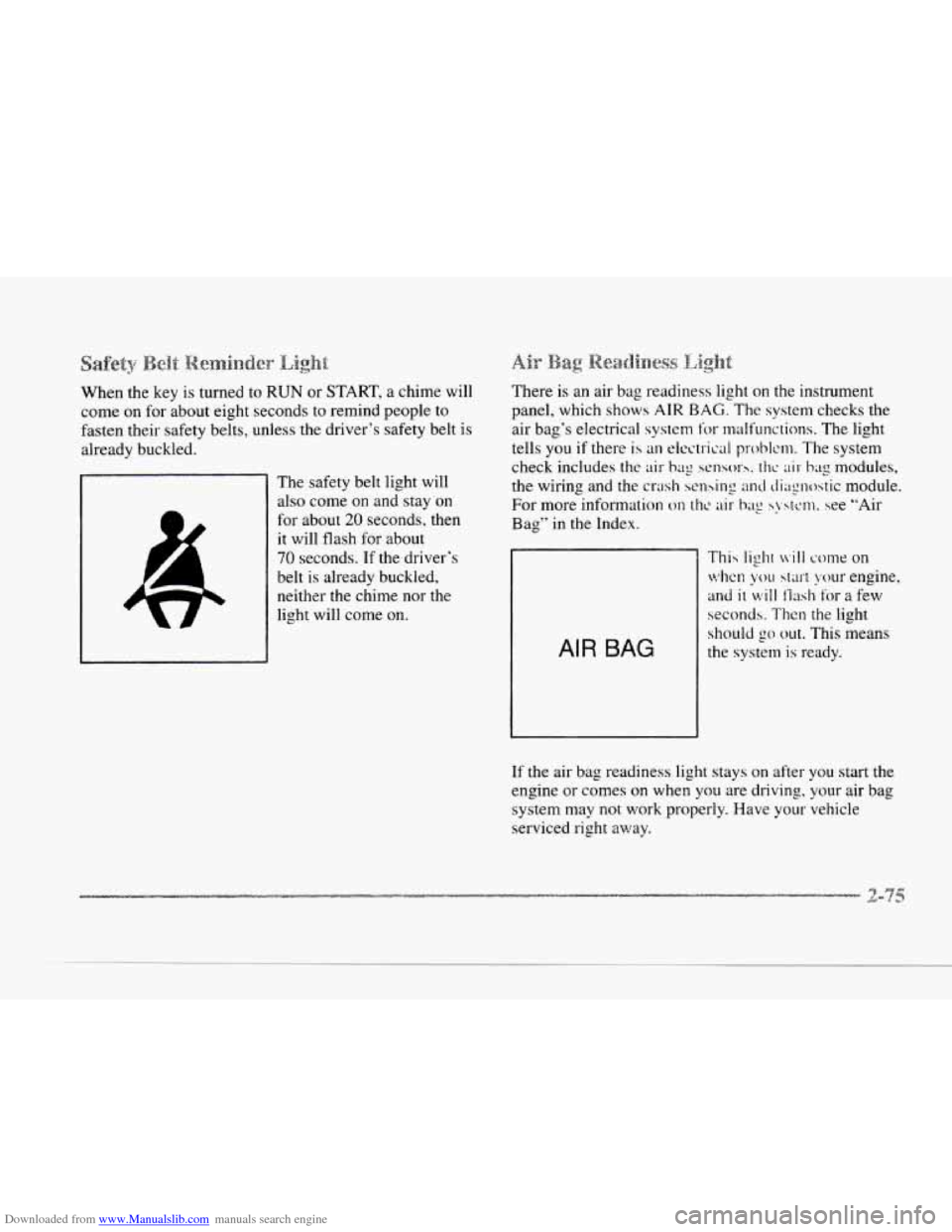
Downloaded from www.Manualslib.com manuals search engine When the key is turned to RUN or START, a chime will
come
on for about eight seconds to remind people to
fasten their safety belts, unless the driver’s safety belt
is
already buckled.
The safety belt light will
also come on and stay on
for about
20 seconds, then
it will flash for about
70 seconds. If the driver’s
belt is already buckled,
neither the chime nor the
light will come on. There
is an
air bag readiness light on the instrument
panel, which shows
AIR BAG. The system checks the
air bag’s electrical system
lor malfunctions. The light
tells you if there
is an eicctrical problm. The system
check includes
the air- hag scnsorh. thc air hug modules,
the wiring and the
crash sensing and tli;tylostic module.
For more information on tht. air bag s!.>tcm. see “Air
Bag” in
the Index.
AIR BAG
This light n*iIl come on
whcn you start your engine,
and
it will t‘iash for a few
seconds.
Then the light
should
go out. This means
the system is ready.
If the air bag readiness light stays on after you start the
engine or comes
on when you are driving, your air bag
system may
not work properly. Nave your vehicle
serviced right away.
Page 140 of 370
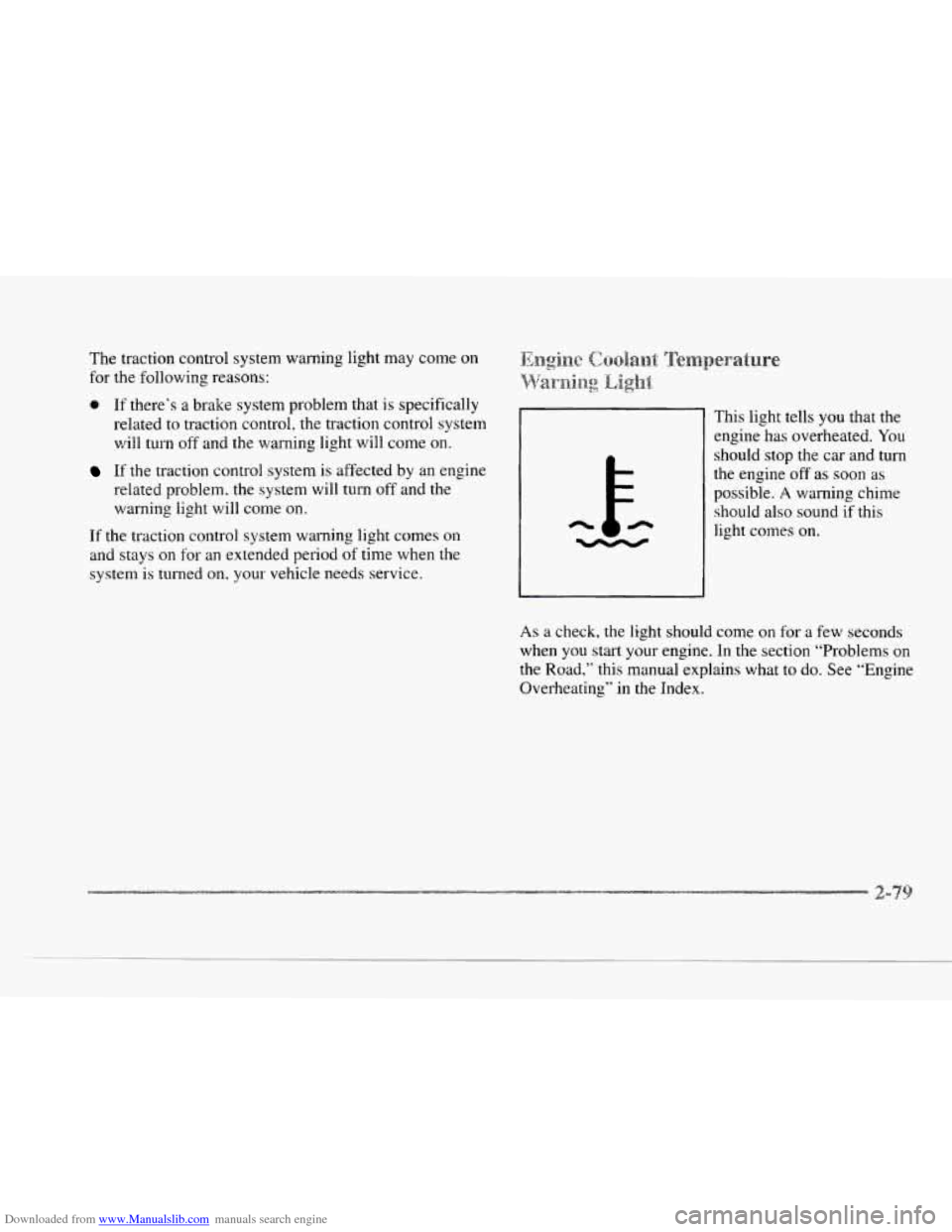
Downloaded from www.Manualslib.com manuals search engine II
LI
The traction control system warning light may come on
for the following reasons:
@ If there’s a brake system problem that is specifically
related to traction control, the traction control system
will turn
off and the warning light will come on.
If the traction control system is affected by an engine
related problem. the system will turn
off and the
warning light will come on.
If the traction control system warning light comes on
and stays on for an extended period of time when the
system is turned
on. your vehicle needs service. This light tells
you that the
engine has overheated. You
should stop
the car and turn
the engine
off as soon as
possible. A warning chime
should also sound if this
light
comes on.
As a check, the light should come on for a few seconds
when
you start your engine. In the section “Problems on
the Road,” this manual explains what to do. See “Engine
Overheating”
in the Index.
Page 142 of 370

Downloaded from www.Manualslib.com manuals search engine c
L-
L-
C
I 1
NOTICE:
If you keep driving your vehicle with this light
on, after a while, your emission controls may not
work as
well, your fuel economy may not be as
good and your engine may not run as smoothly.
This could lead to costly repairs that may not be
covered by your warranty.
This light should come on. as a check to show you it is
working, when the ignition is on and the engine is not
running.
If the light doesn't come on, have it repaired.
This light will
also come on during a malfunction in one
of two ways:
Light Flashing -- A misfire condition has been
detected.
A misfire increases vehicle emissions and
may damage the emission control system on your
vehicle. Dealer or qualified service center diagnosis
and service
is required.
0 Light On Steady -- An emission control system
malfunction has been detected
on your vehicle.
Dealer or qualified service center diagnosis and
service rnay be required. The
following may prevent more serious damage to
your vehicle:
0 Reducing vehicle speed.
0 Avoiding hard accelerations.
Avoiding steep uphill grades.
If you are towing a trailer, reduce the amount of
cargo being hauled as soon as it is possible.
If the light stops flashing and remains on steady, see
"If
the Light Is On Steady" following.
If the light continues to flash, when it is safe to do so,
stop the velzicle. Find a safe place to park your vehicle.
Turn the key
off, wait at least 10 seconds and restart the
engine.
If the light remains on steady, see "lf the Light
Is On Steady" following. If the light is still flashing.
follow the previous steps, and drive the vehicle
to your
dealer or qualified service center for service.
You may
be able to correct the emission system
malfunction by considering the following:
Did you just drive through a deep puddle
of water?
If
so. your electrical system may be wet. The condition
will usually be corrected when the electrical system
dries
out. A few driving trips should turn the light off.
Page 143 of 370
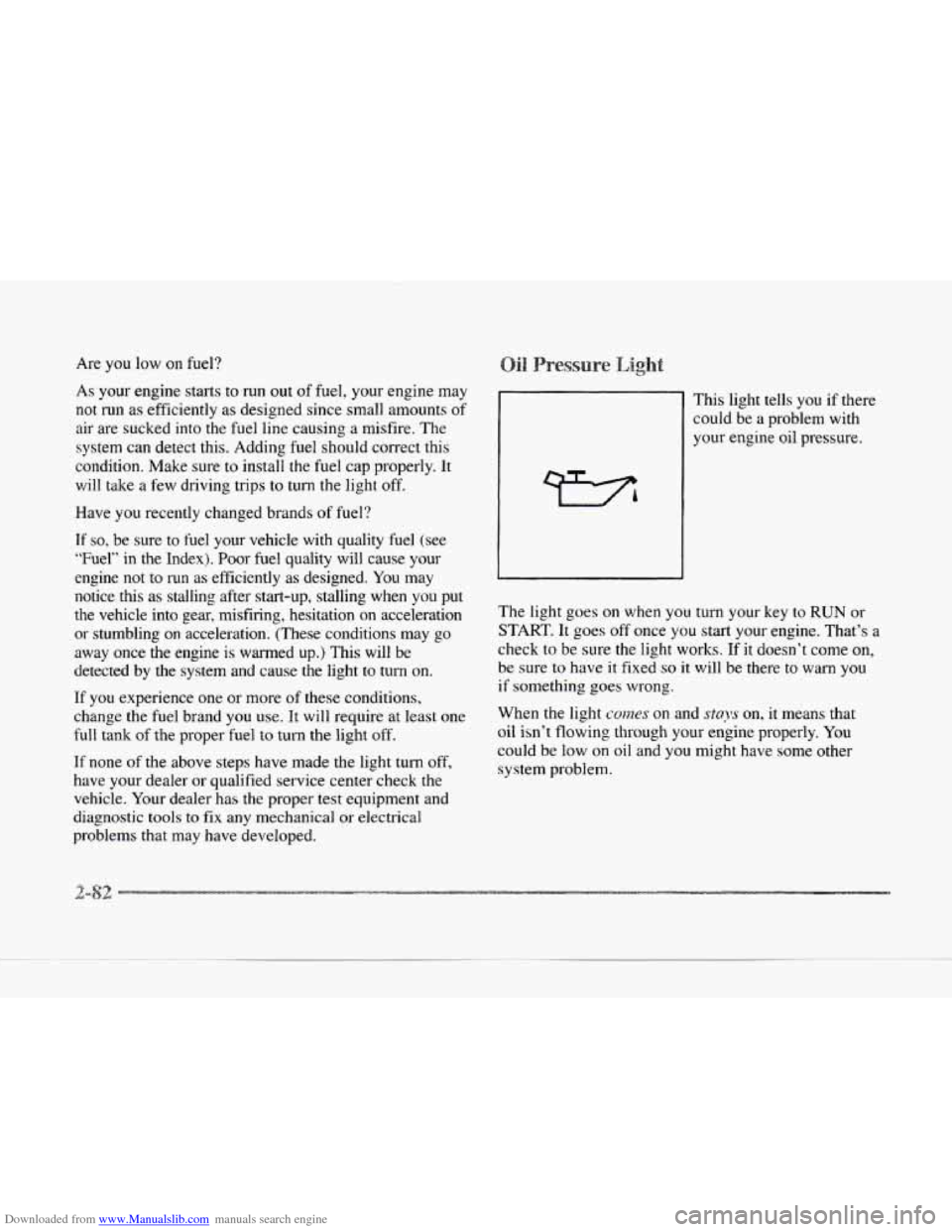
Downloaded from www.Manualslib.com manuals search engine Are you low on fuel?
As your engine starts to run
out of fuel, your engine may
not run as efficiently as designed since small amounts
of
air are sucked into the fuel line causing a misfire. The
system can detect this. Adding fuel should correct this
condition. Make sure to install the fuel
cap properly. It
will take a few driving trips to turn the light off.
Have
you recently changed brands of fuel?
If
so, be sure to fuel your vehicle with quality fuel (see
“Fuel”
in the Index). Poor fuel quality will cause your
engine not to run as efficiently as designed.
You may
notice this as stalling after start-up, stalling when you put
the vehicle into gear, misfiring, hesitation on acceleration
or stumbling on acceleration. (These conditions may go
away once the engine
is warmed up.) This will be
detected by the system and cause the light to
turn on.
If you experience one or more
of these conditions,
change the fuel brand
you use. It will require at least one
full tank of the proper fuel to turn the light off.
If none of the above steps have made the light turn
off,
have your dealer or qualified service center check the
vehicle. Your dealer has the proper
test equipment and
diagnostic tools
to fix any mechanical or electrical
problems that may have developed. This light
tells you if there
could be a problem with
your engine oil pressure.
The light
goes on when you turn your key to RUN or
START. It goes off once you start your engine. That‘s a
check
to be sure the light works. If it doesn’t come on,
be sure to have
it fixed so it will be there to warn you
if something goes wrong.
When
the light comes on and stays on, it means that
oil isn’t flowing through your engine properly.
You
could be low on oil and you might have some other
system problem.
Page 152 of 370
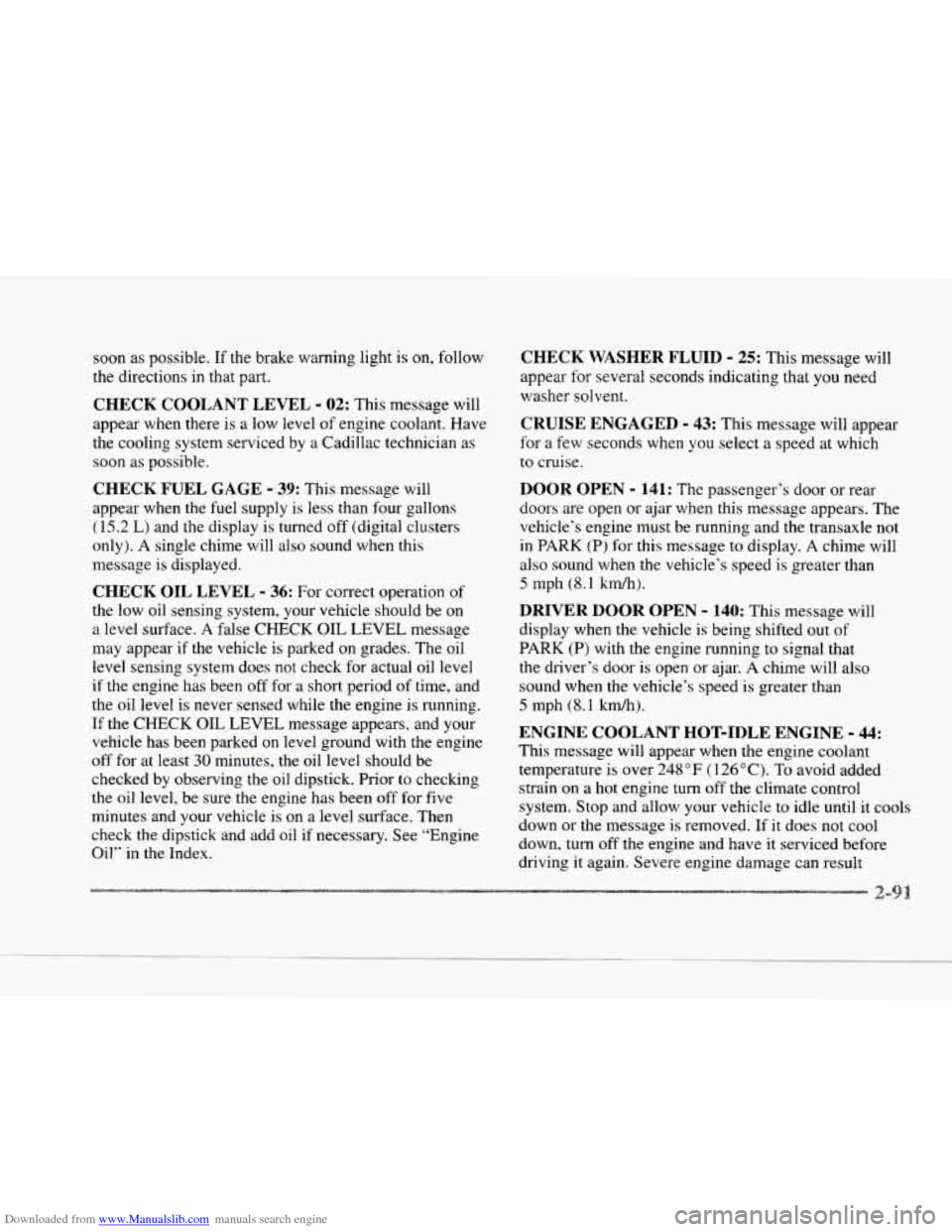
Downloaded from www.Manualslib.com manuals search engine k
soon as possible. If the brake warning light is on, follow
the directions in that part.
CHECK COOLANT LEVEL - 02: This message will
appear when there is a low level of engine coolant. Have
the cooling system serviced by a Cadillac technician as
soon
as possible.
CHECK FUEL GAGE - 39: This message will
appear when the fuel supply
is less than four gallons
(15.2 L) and the display is turned off (digital clusters
only). A single chime will also sound when this
message is displayed.
CHECK OIL LEVEL - 36: For correct operation of
the low oil sensing system, your vehicle should be on
a level surface.
A false CHECK OIL LEVEL message
may appear
if the vehicle is parked on grades. The oil
level sensing system does not check for actual oil level
if the engine has been
off for a short period of time, and
the oil level is never sensed while the engine is running.
If the CHECK OIL LEVEL message appears, and your
vehicle has been parked
on level ground with the engine
off for at least 30 minutes, the oil level should be
checked by observing the oil dipstick. Prior to checking
the oil level, be sure
the engine has been off for five
minutes and your vehicle is on a level surface. Then
check the dipstick and add oil if necessary. See “Engine
Oil” in the Index.
CHECK WASHER FLUID - 25: This message will
appear
for several seconds indicating that you need
washer solvent.
CRUISE ENGAGED - 43: This message will appear
for
a few seconds when you select a speed at which
to cruise.
DOOR OPEN - 141: The passenger’s door or rear
doors are open or ajar when this message appears. The
vehicle’s engine must be running and the transaxle not
in PARK
(P) for this message to display, A chime will
also sound when the vehicle’s speed is greater than
5 mph (8.1 km/h).
DRIVER DOOR OPEN - 140: This message will
display when the vehicle
is being shifted out of
PARK (P) with the engine running to signal that
the driver’s door
is open or ajar. A chime will also
sound when the vehicle’s speed is greater than
5 mph (8.1 kdh).
This message will appear when the engine coolant
temperature
is over 248°F ( 126°C). To avoid added
strain
on a hot engine turn off the climate control
system. Stop and allow your vehicle to idle
until it cools
down or the message is removed.
If it does not cool
down, turn off the engine and have it serviced before
driving it again. Severe engine damage can result
ENGINE COOLANT HOT-IDLE ENGINE - 44:
-9